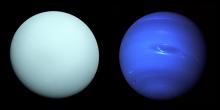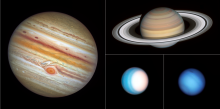Listen to today's episode of StarDate on the web the same day it airs in high-quality streaming audio without any extra ads or announcements. Choose a $8 one-month pass, or listen every day for a year for just $30.
You are here
More Neptune
Astronomers have been studying Neptune for only a bit more than one year — one Neptunian year. The planet takes 165 Earth years to orbit the Sun. But it was discovered just 172 years ago. That means that, since its discovery, it’s made only a bit more than one full orbit, so we’ve seen only one year on the planet.
That’s not a lot of time to learn what’s happening there. Astronomers have seen one cycle of seasons. But seasons can be quite different from one year to the next. And a planet’s overall climate can change, too. So it can take many years to figure out how a planet’s atmosphere works.
And in the case of Neptune, we’ve had really good “eyes” on the planet for only the last few decades. The Voyager 2 spacecraft flew past Neptune in 1989, giving us our only close-up look. Hubble Space Telescope has watched it since the 1990s. And new technologies have greatly improved the view from the ground over that period as well.
So to really to get to know the planet, astronomers will have to keep watching it for years — Earth years and Neptunian years, too.
And this is an especially good time for them to be watching the planet. It lines up opposite the Sun in our sky, so it rises at sunset and is visible all night. Neptune is closest for the year, too — about 2.7 billion miles away — so it’s also at its brightest. Even so, you need a telescope to find this remote giant.
We’ll have more about Neptune tomorrow.






